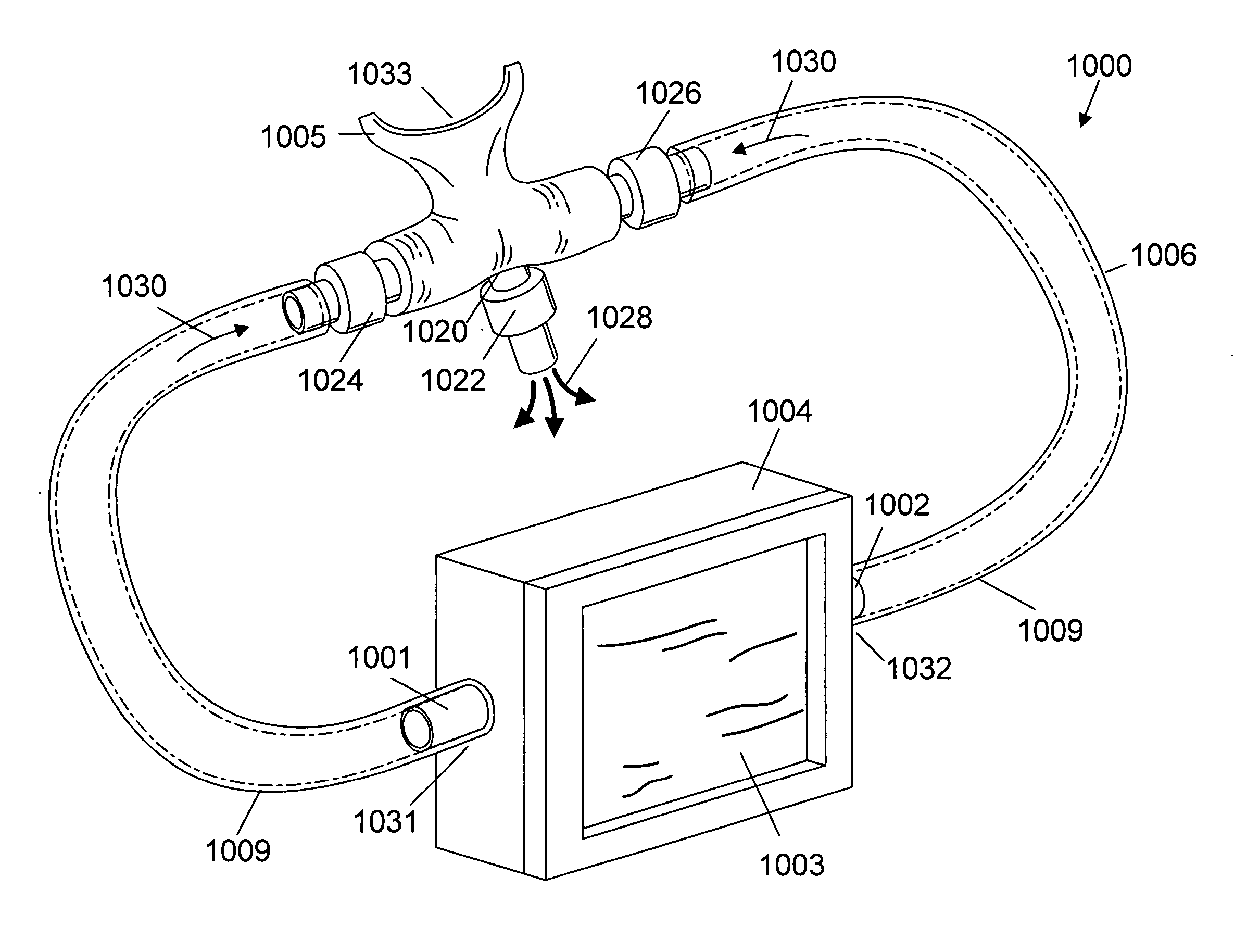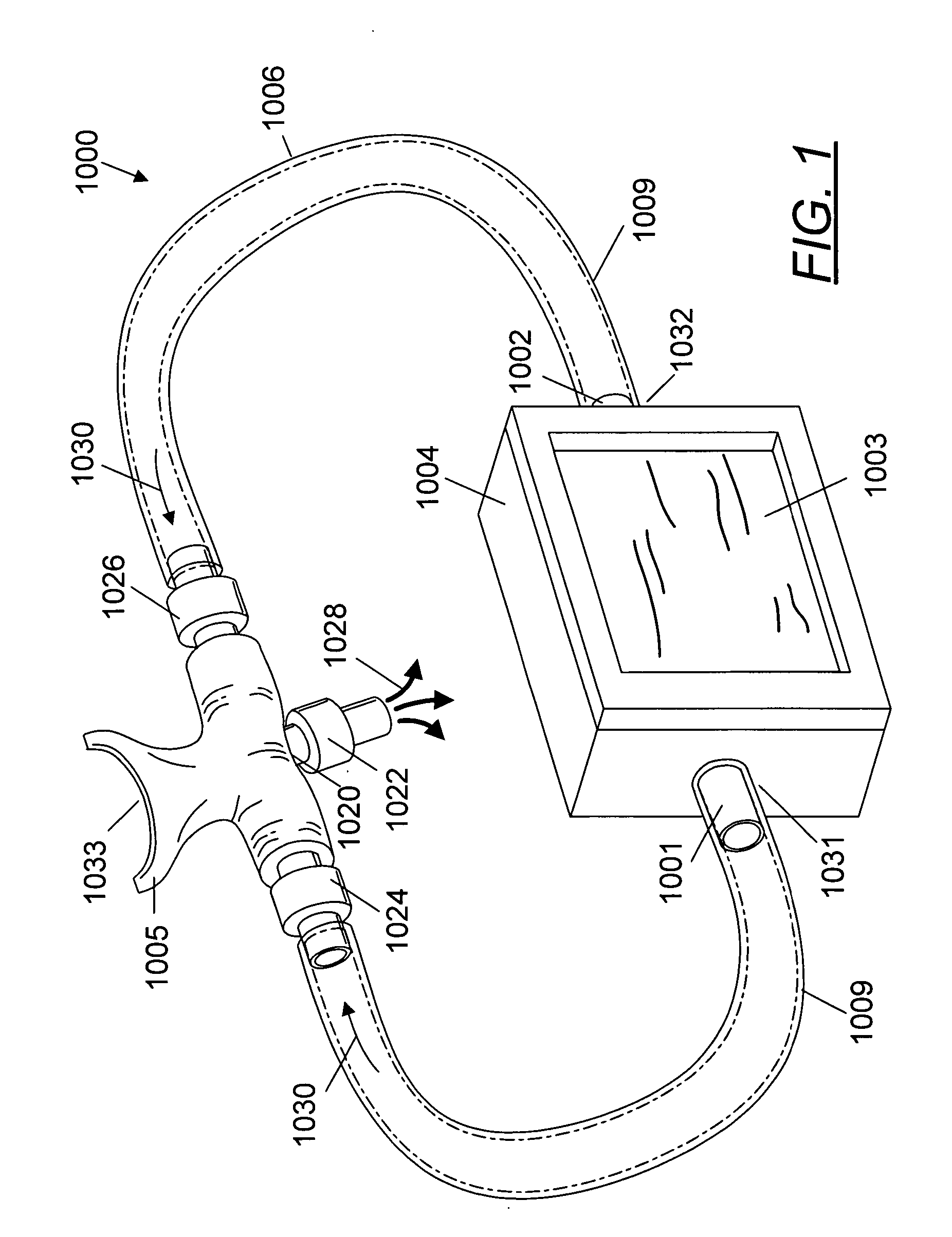Oral respirator device and method for mask-free filtering of particulates from breathed air
a respirator and air filter technology, applied in the direction of breathing filter, breathing protection, protective clothing, etc., can solve the problems of inconvenient use, high manufacturing and maintenance costs, and inability to meet the needs of air quality control,
- Summary
- Abstract
- Description
- Claims
- Application Information
AI Technical Summary
Benefits of technology
Problems solved by technology
Method used
Image
Examples
embodiment 1300
[0111]FIG. 11 depicts an alternative embodiment 1300 of the housing of device 100. In one embodiment depicted, the shape of the housing is a rectangular cube with open side 1302 (there is no wall). As will be apparent, the device is substantially the same as described previously except that the housing 1300 is a unitary piece and the filter 110 is secured to the housing 1300 by straps, ties or rubber bands 124, 128, 126, 130 to the open side 1302 of the housing. The straps, ties or rubber bands fit within small channels 132, 136, 134, 138 that surround the entire periphery of the device. These channels keep the straps, ties or rubber bands from dislocating, thus keeping the filter 110 tightly secured to the housing. In one embodiment, these channels have a diameter of from about one to about 4 millimeters and are disposed at a distance of from about 4 to about 30 millimeters from the outside edge of each side.
[0112] Referring again to FIG. 11, as will be apparent, many configuration...
embodiment 1400
[0119]FIG. 10 depicts a modification to the embodiment depicted in FIG. 9. As will be apparent, the embodiment 1400 in FIG. 10 is substantially identical to that in FIG. 9 except that there are two apertures 716 along the surface of the two opposing side panels 708, 710 and back panel 714. (These apertures are substantially the same as apertures 716 of FIG. 7.) These apertures 716 may be disposed along the surface of the two opposing side panels 708, 710 and back panel 714 in any location that is convenient for the manufacturer or user. Applicant believes that a somewhat central location provides the optimum utility.
[0120] Referring again to FIG. 9, in some embodiments, a one-way respiratory valve 750 is operably connected to the air inlet hole 716. Such respiratory valves are well-known and any suitable one-way valve may be used. By way of example, but not limitation, one may use a valve according to the teachings of U.S. Pat. No. 4,172,467 (Respirator valve for respirators); U.S. ...
embodiment 800
[0123]FIG. 12 depicts a detailed view of a portion of the housing and the oral interface depicted in FIG. 3 and how such parts are operably connected. Referring to FIG. 12 and the embodiment 800 depicted, the male portion 104 of the oral interface (or the unitary piece in some embodiments) is operably connected to the housing 102 at air inlets 114, 116 by press or snap fitting to form a substantially airtight seal. The male portion 104 fits within the female portion 106 of the oral interface by press or snap fitting to form a substantially airtight seal.
[0124] In an embodiment depicted in FIGS. 13A and 13B, the oral interface 900, 950 comprises a plastic tube with a lumen diameter 915, 965 of from about one to about 10 millimeters, more preferably from about four millimeters to about ten millimeters, and most preferably from about 5 to about 7 millimeters. In oral interface 950, the diameter 965 is divided equally between the two bifurcated parts. By way of example, but not limitati...
PUM
 Login to View More
Login to View More Abstract
Description
Claims
Application Information
 Login to View More
Login to View More - R&D
- Intellectual Property
- Life Sciences
- Materials
- Tech Scout
- Unparalleled Data Quality
- Higher Quality Content
- 60% Fewer Hallucinations
Browse by: Latest US Patents, China's latest patents, Technical Efficacy Thesaurus, Application Domain, Technology Topic, Popular Technical Reports.
© 2025 PatSnap. All rights reserved.Legal|Privacy policy|Modern Slavery Act Transparency Statement|Sitemap|About US| Contact US: help@patsnap.com



